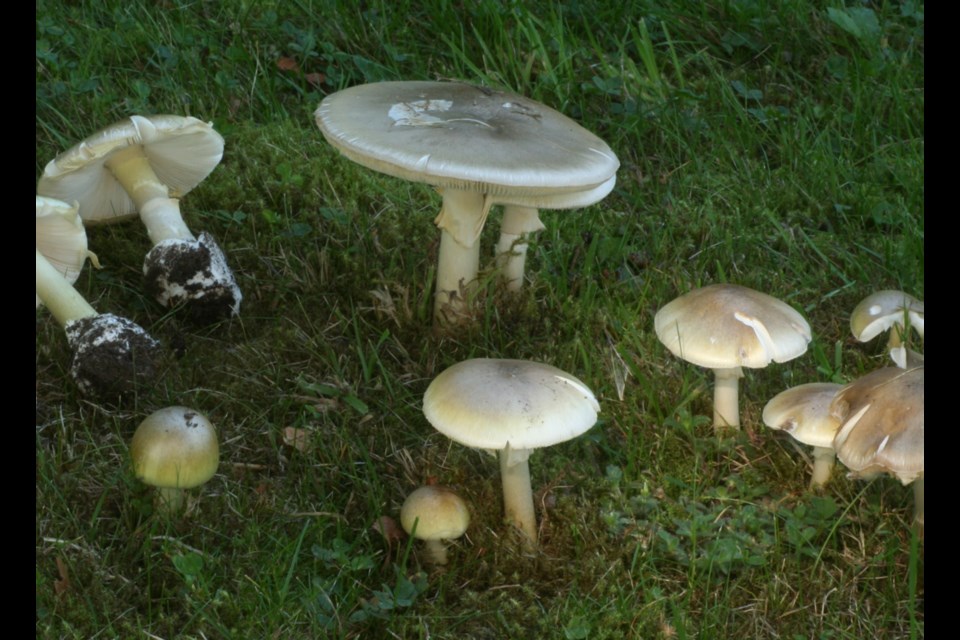The shiny greenish domes poking out of Glenn Nicholls’s lawn don’t look particularly threatening.
But the mushrooms are the same species that killed a three-year-old Victoria boy this week: the “death cap” — one of the deadliest mushroom species in the world.
“That’s news to me,” the Uplands resident said. “I’ve noticed them before and noticed they’re an odd shape, but now I know what they are. There are lots of those all over the yard.”
Nicholls said he didn’t have any children in the house, but his daughter’s dog never took any interest in the mushrooms.
Although 90 per cent of worldwide mushroom deaths have been attributed to death caps, the boy’s was the first documented fatality in B.C., Island Health said.
The invasive species was first reported in the province in 1997, when it was found in Mission, according to the University of British Columbia. It appeared in Victoria in 1998.
The Pacific Forestry Centre’s Forest Pathology Herbarium database has 14 records in B.C., including samples collected at Government House, in a garden on Foul Bay Road, on Richmond Avenue, under linden trees in Uplands, and under hornbeams beside a downtown parking lot and near Crystal Gardens.
Island Health will not say where the toddler’s family foraged the mushrooms, only that it was near the sidewalk on a downtown residential property. There were enough death caps on the property at the time to kill 12 adults, and the remaining samples were removed, said Dr. Richard Stanwick, the health authority’s chief medical officer.
Other samples have been identified in Vancouver, Chilliwack, Langley, Surrey and Galiano Island.
This wasn’t the first case of poisoning. In 2003, David Vickery of Oak Bay barely survived after cooking and eating death caps picked from under an oak tree on Eastdowne Road, thinking they were puffballs.
Pets are also vulnerable. Two dogs died within a week of each other after eating poisonous mushrooms at Elk/Beaver Lake Regional Park in 2007, although the mushroom species responsible was not named.
Identifying death caps
Look up. The death cap grows around ornamental European hardwoods, which were imported to Victoria about 50 years ago. The mushroom pops up around mature English oaks, chestnuts, lindens and hornbeams.
When young, it has a domed cap, which flattens out and cracks as it matures. It is mostly white, with a coloured cap.
“It has a distinctive colour. It’s almost metallic, a kind of brassy yellowish-green,” said Brenda Callan, a mycologist with the Pacific Forestry Centre.
“With heavy rains, it can fade to be almost pale beige; the rain will wash the pigment out. And as it matures, it will go either brown or fade.”
Death cap mushrooms have a distinctive, bulbous volva or cup at the base of the stem underground and a “skirt” below the cap.
Mycologist Brenda Callan describes death cap mushrooms, which killed a Victoria toddler Tuesday, found in Uplands. #yyj @timescolonist pic.twitter.com/ps2WUYU6fc
— Times Colonist (@timescolonist) October 13, 2016
Getting rid of death caps
Individual mushrooms can be picked and removed. But since mushrooms grow from an underground fungal network connected to trees, more will grow, Callan said — unless you remove the whole tree. The best bet is to pick those that are visible and monitor the area through the fall.
“You can’t die from touching them,” Callan said, after handling some samples without gloves. Just be mindful to wash your hands afterward. “The toxin is a very stable one, so cooking or boiling them for a long period of time won’t make them safe.”
Stanwick recommends using gloves as a precaution and double-bagging the mushrooms before disposing of them.
Mushroom safety
There are plenty of healthy, edible species growing in the region, including chanterelle, porcini and pine mushrooms, said Andy MacKinnon, a member of the South Vancouver Island Mycology Society.
• Go with an experienced mushroom hunter or join a club.
• Educate yourself. Take a course. Make sure field guides are local. The society’s annual mushroom show on Oct. 23 will have at least 100 species on display, as well as talks and tours. A list of mushroom events is online at metchosinbiodiversity.com/mushrooms.
• When in doubt, don’t eat it.
Other mushrooms to watch out for
• Amanita pantherina, or “panther cap” mushrooms, are most commonly found around Douglas firs in the spring. They have brown caps with densely distributed white warts and a white stem.
• Amanita smithiana, or Smith’s amanita, is white with a thin, soft veil powder on its cap — although rain may wash away the veil.
• Amanita muscaria, or fly amanita, has a red cap with white spots.
Who is most vulnerable
• Grazing toddlers.
• Someone unfamiliar with local vegetation, who mistakes the mushroom for a species native to another area.
• New hunters who misidentify a mushroom.
• People looking for a recreational drug experience.
Symptoms
Illness begins eight to 12 hours after ingestion, beginning with gastrointestinal symptoms such as vomiting and diarrhea, followed by apparent recovery, according to the B.C. Centre for Disease Control.
Gastrointestinal symptoms recur and damage to the kidney and liver progresses over the next three to six days.
What to do if you think someone ate a poisonous mushroom
Call the B.C. Drug and Poison Information Centre (1-800-567-8911) and seek medical attention or call 911. Keep a sample of the mushroom or food that was eaten.
If possible, collect a sample, including some of the undergrowth. And take note of your surroundings, especially nearby tree species. This will help with identification.



